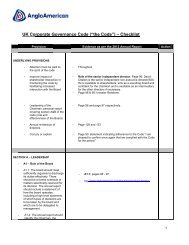Download PDF - Kumba Iron Ore
Download PDF - Kumba Iron Ore
Download PDF - Kumba Iron Ore
Create successful ePaper yourself
Turn your PDF publications into a flip-book with our unique Google optimized e-Paper software.
On disposal of part or all of the investment, the proportionate share of the<br />
related cumulative gains and losses previously recognised in the foreign<br />
currency translation reserve in the statement of changes in equity are<br />
recognised in the income statement on disposal of that investment.<br />
2.4 Segment reporting<br />
Operating segments are reported in a manner consistent with the<br />
internal reporting provided to the chief operating decision-maker.<br />
The chief operating decision-maker, who is responsible for allocating<br />
resources and assessing performance of the operating segments,<br />
has been identified as the <strong>Kumba</strong> Executive Committee.<br />
Management has determined the operating segments of the group<br />
based on the reports reviewed by the Executive Committee that<br />
are used to make strategic decisions. The Executive Committee<br />
considers the business principally according to the nature of the<br />
products and service provided, with the segment representing a<br />
strategic business unit. The reportable operating segments derive<br />
their revenue primarily from mining, extraction, production and selling<br />
of iron ore and shipping operations charged to external clients.<br />
2.5 Post-balance sheet events<br />
Recognised amounts in the financial statements are adjusted to<br />
reflect events arising after the balance sheet date that provide<br />
evidence of conditions that existed at the balance sheet date. Events<br />
after the balance sheet that are indicative of conditions that arose<br />
after the balance sheet date are dealt with by way of a note.<br />
SUBSIDIARIES<br />
Subsidiaries are those entities (including special purpose entities)<br />
over which the group has the power to exercise control. Control<br />
is achieved where the group has the ability, directly or indirectly,<br />
to govern the financial and operating policies of an entity so as to<br />
obtain benefits from its activities.<br />
The financial results of subsidiaries acquired or disposed of during<br />
the year are included in the consolidated income statement from the<br />
effective date of acquisition or up to the effective date of disposal,<br />
as appropriate.<br />
NON-CONTROLLING INTERESTS<br />
The effects of transactions with non-controlling interests are<br />
recorded in equity as transactions with equity owners of the group.<br />
For purchases from non-controlling interests, the difference between<br />
any consideration paid and the relevant share acquired of the<br />
carrying value of net assets of the subsidiary is recorded in equity.<br />
Gains or losses on disposals to non-controlling interests are also<br />
recorded in equity.<br />
When the group ceases to have control or significant influence, any<br />
retained interest in the entity is remeasured to its fair value, with<br />
the change in carrying amount recognised in profit or loss. The fair<br />
value is the initial carrying amount for the purposes of subsequently<br />
accounting for the retained interest as an associate, joint venture<br />
or financial asset. In addition, any amounts previously recognised<br />
in comprehensive income in respect of that entity are accounted<br />
for as if the group had directly disposed of the related assets or<br />
liabilities. This may mean that amounts previously recognised in<br />
comprehensive income are reclassified to profit or loss.<br />
2.6 Comparative figures<br />
Comparative figures are restated in the event of a change in<br />
accounting policy.<br />
3. COMPANY FINANCIAL STATEMENTS<br />
Subsidiaries, associates and joint ventures<br />
Investments in subsidiaries, associates and joint ventures in the<br />
separate financial statements presented by <strong>Kumba</strong> are recognised<br />
at cost less accumulated impairment.<br />
4. CONSOLIDATED FINANCIAL STATEMENTS<br />
4.1 Basis of consolidation<br />
The consolidated financial statements present the financial position<br />
and changes therein, operating results and cash flow information of<br />
the group. The group comprises <strong>Kumba</strong>, its subsidiaries and interests<br />
in joint ventures and associates.<br />
Where necessary, adjustments are made to the results of<br />
subsidiaries, joint ventures and associates to ensure the consistency<br />
of their accounting policies with those used by the group.<br />
Intercompany transactions, balances and unrealised profits and<br />
losses between group companies are eliminated on consolidation.<br />
In respect of joint ventures and associates, unrealised profits and<br />
losses are eliminated to the extent of the group’s interest in these<br />
entities. Unrealised profits and losses arising from transactions with<br />
associates are eliminated against the investment in the associate.<br />
ASSOCIATES<br />
Associates are investments over which the group is in a position to<br />
exercise significant influence, but not control or joint control, through<br />
participation in the financial and operating policy decisions of the<br />
investee. Typically the group owns between 20% and 50% of the<br />
voting equity.<br />
Investments in associates are accounted for using the equity<br />
method of accounting from the date on which significant influence<br />
commences until the date that significant influence ceases, and are<br />
initially recognised at cost.<br />
Under this method the group’s share of post-acquisition profits or<br />
losses of associates is recognised in the income statement as equity<br />
accounted earnings and its share of movements in post-acquisition<br />
equity reserves is recognised in the statement of changes in<br />
equity. All cumulative post-acquisition movements in the equity of<br />
associates are adjusted against the carrying value of the investment.<br />
When the group’s share of losses in associates equals or exceeds<br />
its interest in those associates, the group does not recognise<br />
further losses, unless the group has incurred a legal or constructive<br />
obligation or made payments on behalf of those associates.<br />
If the ownership interest in an associate is reduced but significant<br />
influence is retained, only a proportionate share of the amounts<br />
previously recognised in comprehensive income are reclassified to<br />
profit or loss where appropriate.<br />
Goodwill identified on acquisition relating to associates is included in<br />
the carrying value of those associates.<br />
The total carrying value of associates, including goodwill, is evaluated<br />
annually for impairment or when conditions indicate that a decline<br />
in fair value below the carrying amount is other than temporary. If<br />
impaired, the carrying value of the group’s share of the underlying<br />
net assets of associates is written down to its estimated recoverable<br />
Audited annual financial statements<br />
Annual Financial Statements 2011<br />
29


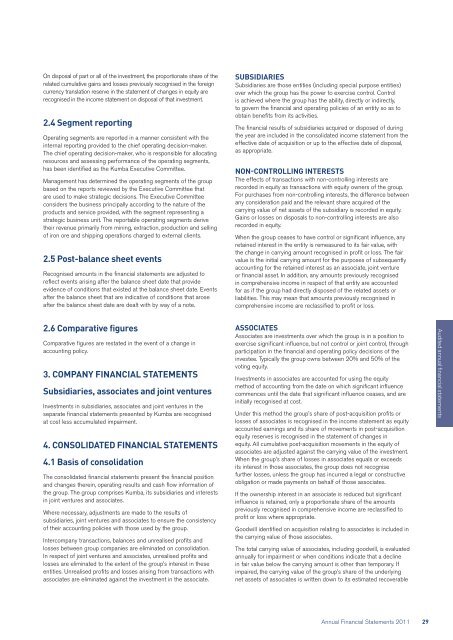
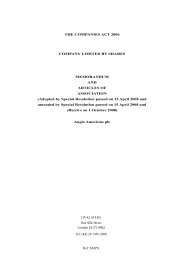
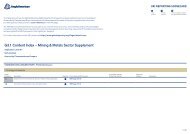
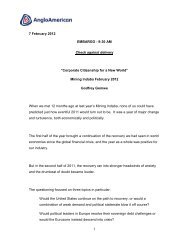


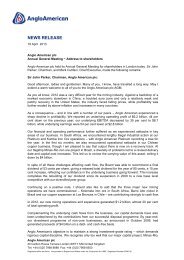
![English PDF [ 189KB ] - Anglo American](https://img.yumpu.com/50470814/1/184x260/english-pdf-189kb-anglo-american.jpg?quality=85)


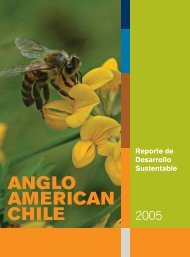

![pdf [ 595KB ] - Anglo American](https://img.yumpu.com/49420483/1/184x260/pdf-595kb-anglo-american.jpg?quality=85)
![pdf [ 1.1MB ] - Anglo American](https://img.yumpu.com/49057963/1/190x240/pdf-11mb-anglo-american.jpg?quality=85)
